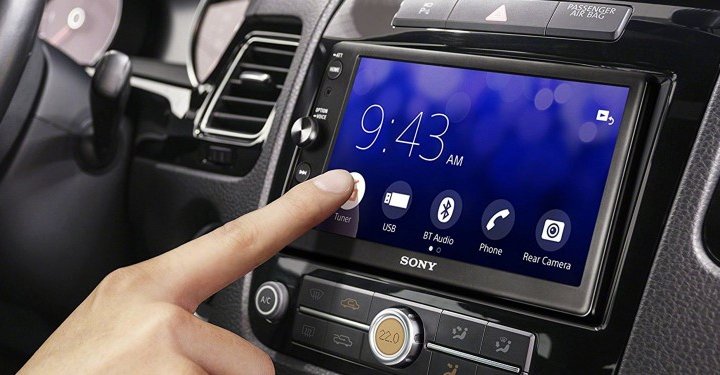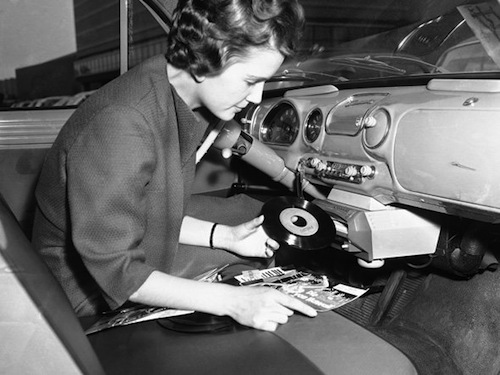Ever since the Galvin brothers introduced the first car radio — the Motorola — back in 1930, we’ve enjoyed all sorts of audio while behind the wheel. For decades, the radio was our main source of entertainment and information while we travelled from point A to point B.
Lately, though, the trusty car radio has been under siege. First up was Telsa, which refused to include AM radio in its vehicles because the electromagnetic fields generated by the car’s motors can make the reception of AM signals difficult if not impossible. Other EV manufacturers have followed suit with some (but not all) of their models. This includes Ford, which dropped AM from its 2023 electric F-150 Lightning even though it was standard equipment in the 2022 version. Odd.
Now, though, Ford is taking things even further. Its next Mustang — the internal combustion kind — will no longer have an AM radio as of the 2024 model year. In fact, AM will soon disappear from all Ford models.
Mazda, Volvo, Polestar, Rivian, and Volkswagen all think that the time is right to dump AM radio. That won’t sit well with drivers who depend on AM stations that deliver news, traffic, and sports, especially play-by-play. AM is on its way to becoming the new shortwave. (It will not go quietly, though. The National Association of Broadcasters in the U.S. has launched a campaign defending AM.)
This is part of a worldwide trend to modernize what auto manufacturers allow in their dashboards, something that goes beyond just AM radio. Way beyond.
The majority of revenue for automobile dealers comes not from selling new vehicles. The real money comes with providing service and repairs.
In contrast, EVs, in general, don’t require as much regular maintenance as gas-powered vehicles. EVs have fewer moving parts. They don’t need oil changes, spark plugs, air filters, fuel pumps, water pumps, and exhaust systems. They don’t have complicated multi-speed transmissions. There are fewer components to wear out and break down. Without this need for service, manufacturers and dealers are gradually and inevitably losing a revenue stream to which they’ve been accustomed for more than a hundred years.
Something needs to replace it. And that something is subscriptions.
Vehicles are turning into computers on wheels, run by millions of lines of code. And thanks to cellular technology, cars are increasingly becoming constantly connected to distant servers.
Tesla owners have become accustomed to dealing with software updates that can update, enhance, or alter the various operations of the vehicle. You may have already heard about BMW’s move to charge a subscription fee for heated seats. Ford has a patent that will allow the company to shut down your AC if you miss a payment.
So what does this have to do with AM/FM radio? Plenty, as it turns out.
After ceding ground in infotainment systems to Apple CarPlay and Android Auto, manufacturers want to wrest back control and go back to the days of providing proprietary infotainment solutions, systems over which they will have complete control. Want a specific entertainment option for your commute? You won’t be going to the App Store. You’ll be contacting the maker of your vehicle who will then push a software update to your car. For an ongoing fee, of course.
GM is all over this. Just as Apple is planning to offer even more integration with cars, GM announced that it will reject “phone projection” interfaces in favour of its own system based on Google technology and software that will be inextricably intertwined with vehicle systems, a partnership that began in 2019.
The company is moving ahead even though every consumer survey I’ve seen says CarPlay is far more popular than Google’s Android Auto. The first vehicle to deny any phone integration will apparently be the 2024 Blazer EV. CarPlay and the current Android Auto offerings will still have limited Bluetooth connectivity, which means users will be limited to streaming music from their phones to the car. No more bespoke displays when you plug in your device.
More models will follow. In fact, the company thinks this could result in up to US$25 billion in revenue by 2030.
Proponents of this change point to satellite radio. Over the last quarter-century, drivers have shown that they will pay for this kind of radio. And let’s not forget that SiriusXM pays manufacturers for its place in dashboards. If that’s the case, it’s not that much of a leap for automakers to move to a situation where they charge a subscription for other radio tuner software — say Radioplayer Canada or TuneIn — that offers access to terrestrial radio. That could mean we’ll have to pay for AM and FM.
Yep. No more free audio entertainment from your car via the good ol’ AM or FM radio in the dashboard. The only antenna the vehicle will have is something that receives 5G (and beyond) signals for streaming data directly to the dashboard.
This scenario is still a few years off. Some manufacturers, Stellantis and Hyundai among them, have stated that they’re going to keep AM radio in their vehicles for the foreseeable future. Others, like Volvo, are siding with Ford. If that weren’t enough, we’re also hearing more about European automakers who may not include any old-school radios at all.
The car has been terrestrial radio’s most important environment for decades. This may change sooner than we may think. And it’s going to cost us.

 globalnews.ca
globalnews.ca
Lately, though, the trusty car radio has been under siege. First up was Telsa, which refused to include AM radio in its vehicles because the electromagnetic fields generated by the car’s motors can make the reception of AM signals difficult if not impossible. Other EV manufacturers have followed suit with some (but not all) of their models. This includes Ford, which dropped AM from its 2023 electric F-150 Lightning even though it was standard equipment in the 2022 version. Odd.
Now, though, Ford is taking things even further. Its next Mustang — the internal combustion kind — will no longer have an AM radio as of the 2024 model year. In fact, AM will soon disappear from all Ford models.
Mazda, Volvo, Polestar, Rivian, and Volkswagen all think that the time is right to dump AM radio. That won’t sit well with drivers who depend on AM stations that deliver news, traffic, and sports, especially play-by-play. AM is on its way to becoming the new shortwave. (It will not go quietly, though. The National Association of Broadcasters in the U.S. has launched a campaign defending AM.)
This is part of a worldwide trend to modernize what auto manufacturers allow in their dashboards, something that goes beyond just AM radio. Way beyond.
The majority of revenue for automobile dealers comes not from selling new vehicles. The real money comes with providing service and repairs.
In contrast, EVs, in general, don’t require as much regular maintenance as gas-powered vehicles. EVs have fewer moving parts. They don’t need oil changes, spark plugs, air filters, fuel pumps, water pumps, and exhaust systems. They don’t have complicated multi-speed transmissions. There are fewer components to wear out and break down. Without this need for service, manufacturers and dealers are gradually and inevitably losing a revenue stream to which they’ve been accustomed for more than a hundred years.
Something needs to replace it. And that something is subscriptions.
Vehicles are turning into computers on wheels, run by millions of lines of code. And thanks to cellular technology, cars are increasingly becoming constantly connected to distant servers.
Tesla owners have become accustomed to dealing with software updates that can update, enhance, or alter the various operations of the vehicle. You may have already heard about BMW’s move to charge a subscription fee for heated seats. Ford has a patent that will allow the company to shut down your AC if you miss a payment.
So what does this have to do with AM/FM radio? Plenty, as it turns out.
After ceding ground in infotainment systems to Apple CarPlay and Android Auto, manufacturers want to wrest back control and go back to the days of providing proprietary infotainment solutions, systems over which they will have complete control. Want a specific entertainment option for your commute? You won’t be going to the App Store. You’ll be contacting the maker of your vehicle who will then push a software update to your car. For an ongoing fee, of course.
GM is all over this. Just as Apple is planning to offer even more integration with cars, GM announced that it will reject “phone projection” interfaces in favour of its own system based on Google technology and software that will be inextricably intertwined with vehicle systems, a partnership that began in 2019.
The company is moving ahead even though every consumer survey I’ve seen says CarPlay is far more popular than Google’s Android Auto. The first vehicle to deny any phone integration will apparently be the 2024 Blazer EV. CarPlay and the current Android Auto offerings will still have limited Bluetooth connectivity, which means users will be limited to streaming music from their phones to the car. No more bespoke displays when you plug in your device.
More models will follow. In fact, the company thinks this could result in up to US$25 billion in revenue by 2030.
Proponents of this change point to satellite radio. Over the last quarter-century, drivers have shown that they will pay for this kind of radio. And let’s not forget that SiriusXM pays manufacturers for its place in dashboards. If that’s the case, it’s not that much of a leap for automakers to move to a situation where they charge a subscription for other radio tuner software — say Radioplayer Canada or TuneIn — that offers access to terrestrial radio. That could mean we’ll have to pay for AM and FM.
Yep. No more free audio entertainment from your car via the good ol’ AM or FM radio in the dashboard. The only antenna the vehicle will have is something that receives 5G (and beyond) signals for streaming data directly to the dashboard.
This scenario is still a few years off. Some manufacturers, Stellantis and Hyundai among them, have stated that they’re going to keep AM radio in their vehicles for the foreseeable future. Others, like Volvo, are siding with Ford. If that weren’t enough, we’re also hearing more about European automakers who may not include any old-school radios at all.
The car has been terrestrial radio’s most important environment for decades. This may change sooner than we may think. And it’s going to cost us.

How much longer will new vehicles come with AM/FM radios? - National | Globalnews.ca
You may have heard that some carmakers will stop offering AM radio. Alan Cross explains the move is part of something that goes beyond just AM radio — way, way beyond.


